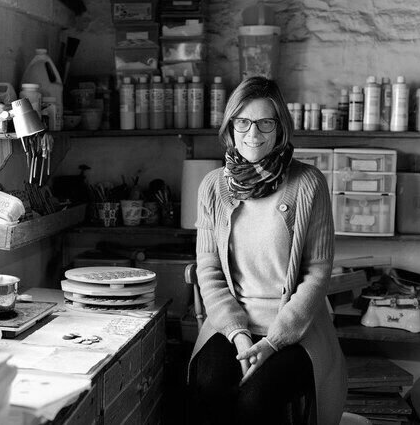
This brooch has been handmade by Stockwell Ceramics, based in the Tamar Valley in Cornwall. Mary Goldberg opened Stockwell Ceramics in 1989, in the beginning making domestic pottery and one-off pieces. But it was not long before Mary moved into making ceramic buttons. From buttons it was an easy step to include jewellery to the range of products. Stockwell Ceramics mainly use white earthenware clay which is then decorated with brightly coloured slips and glazes. Each piece is individually cut and glazed making them completely unique.

Today Stockwell Ceramics are sold in many of the main museums in the UK including the V&A, the British Museum and the National Museum of Scotland. I bought this brooch in the Towner Gallery in Eastbourne where they have one of the largest public collections of Eric Ravilious’s work. Stockwell Ceramics have taken the stylized concepts of Eric Ravilious’s technique called ‘manière criblée’ to create this brooch. This technique was invented in the fifteenth century for metal engraving producing the effect of small dots and dashes across an image. Ravilious used this method to create the softly stippled tonal contrasts, patterns and textures so characteristics in his work.

Eric Ravilious was born on 22 July 1903 in London to Emma and Frank, the family moved to Eastbourne when Eric was four. At School Eric excelled at cricket and art, his mother wanted him to go into the Post Office, seeing it as a stable career but with the encouragement of his art teacher Mr Millington, Eric applied and was accepted at the Royal College of Art in London. While at the RCA Eric was taught by the surrealist artist Paul Nash, who encouraged him to use watercolour and develop wood engraving techniques. Eric is particularly known for his watercolours of English landscapes but he was also a designer, book illustrator and wood-engraver. During the 1930s he worked as a designer for Wedgewood, today Ravilious crockery is much sought after. It is one of those things I look out for when antiques hunting but so far no luck. During WWII Eric became an official war artist, his clean graphic style bringing into sharp perspective the realities of war.

In 1942, at only 39, Eric Ravilious flew to an RAF base in Iceland. On the day he arrived an aircraft had failed to return from a patrol. Three aircraft were despatched to search for the missing plane and Eric opted to join one of the crews. The aircraft he was on also failed to return and after four days of further searching, the RAF declared Eric Ravilious and the four-man crew lost in action their bodies have never been recovered.

